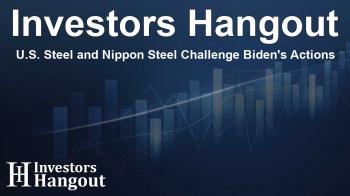U.S. Steel and Nippon Steel Challenge Biden's Actions

U.S. Steel and Nippon Steel Legally Challenge Biden's Decision
U.S. Steel and Nippon Steel have announced their legal action against the current administration following a controversial block on their planned $14.9 billion acquisition deal. Their lawsuit comes as a critical move in a high-stakes saga that has captivated the steel industry.
Timeline of Key Events Leading to the Lawsuit
The path to this legal battle has been marked by a series of pivotal moments. U.S. Steel first signaled interest in exploring strategic options amidst unsolicited acquisition bids from various companies. Initially, on August 13, major headlines emerged, signaling possibilities ranging from partial asset acquisitions to proposals encompassing the entire company.
Acquisition Bids and Rejections
On the same day, U.S. Steel proudly announced it had officially declined a substantial $7.3 billion offer from Cleveland-Cliffs. This rejection prompted a thorough evaluation of their available options forward. Shortly after, union support began favoring Cleveland-Cliffs, indicating a growing consensus on potential buyers among labor organizations.
Investor Interests Spike
Interest in U.S. Steel peaked when the firm Esmark made a competing all-cash offer amounting to $7.8 billion. As the landscape continued to shift, the world-renowned ArcelorMittal also expressed a willingness to consider making an offer. These rapid developments signaled a boisterous market in the steel sector, with various stakeholders vying for control.
Nippon Steel Steps In Amid Growing Opposition
By late December, Nippon Steel revealed plans to acquire U.S. Steel, resulting in immediate scrutiny and concern from various political figures. The deal raised significant national security considerations, leading the White House to call for a deeply analytical review of the implications surrounding such a merger.
Regulatory Challenges and Political Backlash
The political landscape became even more tumultuous when numerous Republican senators urged for an outright halt to the transaction. By early January, contrary to Nippon's expectations, discussions shifted as the administration publicly expressed doubts about the benefits of the acquisition.
Legal Repercussions and Actions Taken
Despite Nippon Steel's assertive lobbying and commitments to American manufacturing, resistance mounted. By January 2025, President Biden outright blocked the acquisition, citing serious national security risks. In direct response, U.S. Steel and Nippon Steel filed their lawsuit against this decision, further entrenching the rivalry among industry competitors.
Industry-Wide Implications and Future Outlook
The implications of this lawsuit reach far beyond the two companies involved. The ongoing challenges underscore the complex interaction between corporate governance and governmental oversight in an ever-globalized economy. It raises questions about how foreign investments will be viewed now and in the future, especially when intertwined with national security considerations.
Potential Impact on Market Dynamics
As U.S. Steel and Nippon Steel navigate the legal landscape, many analysts are closely monitoring how this litigation will affect both companies’ future growth and stability. Investors now wonder whether similar mergers will face greater scrutiny as a result of this high-profile case.
Conclusion: A Battle for Control and Identity
This legal battle represents not only a fight for a lucrative business deal but also serves as a broader commentary on corporate America’s identity in the face of foreign investment and governmental interference. Stakeholders from various sectors are carefully evaluating the outcome of this case, as it may set a national precedent for future mergers and acquisitions.
Frequently Asked Questions
What is the primary reason for U.S. Steel and Nippon Steel's lawsuit?
The lawsuit challenges President Biden's decision to block their $14.9 billion acquisition deal, citing unfair treatment and regulatory overreach.
How did the political climate affect the acquisition?
Concerns over national security and increased scrutiny from politicians resulted in growing opposition to Nippon Steel's plans, causing significant regulatory hurdles.
What were some notable offers made for U.S. Steel?
U.S. Steel received offers from Cleveland-Cliffs and Esmark, with Cleveland-Cliffs offering $7.3 billion initially, which was formally rejected.
What factors are influencing the ongoing debate about American steel?
Key factors include national security concerns, labor union positions, and market dynamics, all of which are intertwined with political influences.
What are the potential outcomes of this legal battle?
Potential outcomes include overturning the block, further regulatory scrutiny, or new legislative measures concerning foreign acquisitions in the U.S. steel industry.
About Investors Hangout
Investors Hangout is a leading online stock forum for financial discussion and learning, offering a wide range of free tools and resources. It draws in traders of all levels, who exchange market knowledge, investigate trading tactics, and keep an eye on industry developments in real time. Featuring financial articles, stock message boards, quotes, charts, company profiles, and live news updates. Through cooperative learning and a wealth of informational resources, it helps users from novices creating their first portfolios to experts honing their techniques. Join Investors Hangout today: https://investorshangout.com/
Disclaimer: The content of this article is solely for general informational purposes only; it does not represent legal, financial, or investment advice. Investors Hangout does not offer financial advice; the author is not a licensed financial advisor. Consult a qualified advisor before making any financial or investment decisions based on this article. The author's interpretation of publicly available data shapes the opinions presented here; as a result, they should not be taken as advice to purchase, sell, or hold any securities mentioned or any other investments. The author does not guarantee the accuracy, completeness, or timeliness of any material, providing it "as is." Information and market conditions may change; past performance is not indicative of future outcomes. If any of the material offered here is inaccurate, please contact us for corrections.
